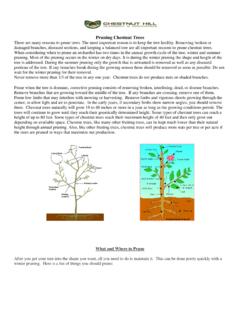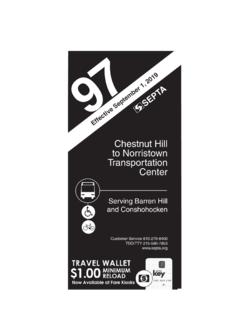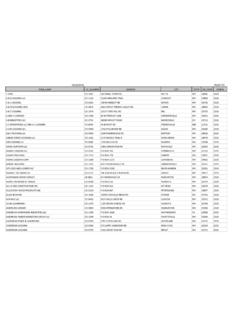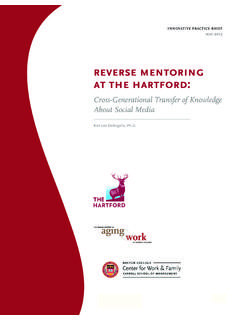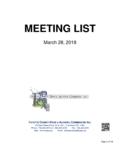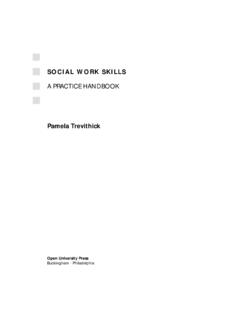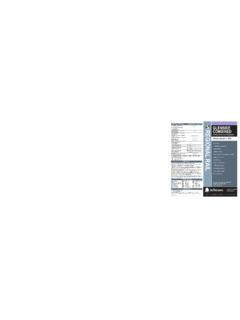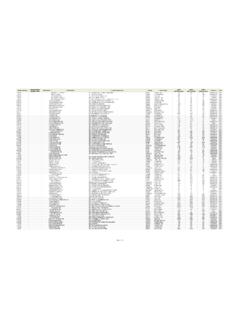Transcription of Information for Growing Chestnut Trees
1 Growing Chestnut Trees S. L. Anagnostakis 1 The connecticut Agricultural Experiment Station ( ) Dr. Sandra L. Anagnostakis Department of Plant Pathology and Ecology The connecticut Agricultural Experiment Station 123 Huntington Street, P. O. Box 1106 New Haven, CT 06504 Phone: (203) 974-8498 Fax: (203) 974-8502 Founded in 1875 E-mail: Putting science to work for society Website: Growing Chestnut Trees Why grow chestnuts? A few acres of land can yield nuts for your own enjoyment or for sale at the side of the road or to your local market. Chestnuts are a good food, as shown in this table: Species Fiber % Protein % Fat % Carbohydrates % Calories per ounce Chinese 14 8 2 65 66 European 14 6 4 66 57 Japanese 14 8 90 114 American 19 10 10 40 70 This is a guide for choosing the right Chestnut species, choosing the right planting site, and anticipating the care that is needed.
2 For a few Trees for your own use, you would do well to get two or three cultivars and plant them near each other (within 100 feet) for optimal cross-pollination. If you are starting an orchard for commercial production, you would be better off with a lot of Trees of a few cultivars and a couple of seedling Trees to provide pollen. The advantage of a uniform orchard is that the nuts all ripen at the same time, and will be fairly uniform in size and appearance (something consumers seem to think is important). The other point to remember for selling the nuts is that bigger is worth more even though smaller nuts frequently taste better! All species of chestnuts can pollinate each other, but hybrids often produce no pollen (are male sterile ) and this must be determined when planning your orchard. Chestnut Blight Disease must be considered in the eastern , Ink Disease (caused by Phytophthora) may be a problem in the south or in areas with poor drainage, Chestnut Gall Wasp is slowly moving north from Georgia, Alabama, North and South Carolina, and Tennessee and was recently found in Ohio, and drought tolerance will make a big difference in the west.
3 The initial investment will include purchase of Trees , tree shelters to protect them, and installation of an irrigation system. Named cultivars are clones of Trees whose characteristics are known. Since they are identical, and chestnuts will not self-pollinate, two or more cultivars (or some seedlings, which are all different) must be planted to provide pollen for each other. Cultivars are grafted onto compatible rootstocks, and they usually cost about $15 each (see sources list appended). The choice of Growing Chestnut Trees S. L. Anagnostakis 2 The connecticut Agricultural Experiment Station ( ) cultivar must be made for your own environmental conditions and taste, and some guidelines can be found in our list of cultivars (e-mail for a copy).
4 Information on nut size has not been systematically collected in all of the Growing regions for cultivars, so the following is only to provide a general range of the sizes available: Cultivar Number of nuts per pound* 'Okei' 12-15 'Colossal 14-18 'Bouche de Betizac' 15 Willamette' 18-22 'Qing' 20 'Sleeping Giant' 28-34 *From J. M. Nave. 1998. Large Fruited Chestnuts Grown in North America, 89th Annual Report of the Northern Nut Growers Association, pages 42-82. Tree shelters can be made of wire or plastic, or can be as simple as piled brush to protect the Trees from deer. The plastic tubes cost about $ each and are easy to install, but must be lifted each fall to allow the Trees to harden off properly. They frequently harbor wasps, and provide a nice environment for rodents who then eat the tree bark. A better shelter may be a sturdy enclosure of hardware cloth (expanded metal) about 3 feet in diameter.
5 An irrigation system is essential for a commercial orchard, even if you live in a region where rainfall is fairly dependable. Plant your Trees in well-drained sandy loam, better drained than apples require. Sites with clay may be tolerated if there is good surface drainage (slope). Chestnuts need a soil pH of to and absolutely won t tolerate limestone soils. If your soil pH is much higher than this, consider another crop. Space the Trees at 40 feet apart, or start at 25 feet apart and remove Trees , as they mature, to 35 feet apart. Fertilize (SPRING ONLY) with one pound of 5-10-5 or 10-10-10 per year of tree age, or one pound per inch of tree trunk diameter. Pruning can be done when it is hot and dry, in early summer (never later than the middle of July). This reduces the chance of infection. Pruning in late winter while Trees are dormant is also possible. The area around the Trees should be kept mowed, and a circle about three feet wider than the diameter of the Trees should be kept weed-free.
6 Mulch can be applied to help with water retention, but should not be deeper than two inches, and should not be up against the trunks (allowing easy access by rodents in the winter). The value of the nuts is directly related to the size, but is usually at least $ per pound wholesale and up to $ per pound retail. Yield will start to be significant after the Trees are 10 years old, and yields have been reported of from 14 pounds per tree to 138 pounds per tree. The traditional method of harvest is to allow the nuts to fall to the ground, and employ people to pick them up. For a few nuts for your own table this is not a bad system, but commercial Growing Chestnut Trees S. L. Anagnostakis 3 The connecticut Agricultural Experiment Station ( ) orchards need more efficient methods.
7 Nets can be suspended under the bottom branches of the Trees to collect the nuts (they should be removed from the nets every day), or some of the marketed ground-collection systems can be used (see advertisements in the Northern Nut Growers Newsletter). The most serious problem for all Chestnut growers is the presence of Chestnut weevils that lay their eggs in the ripening nuts. When the nuts fall to the ground, the eggs hatch, and the larvae eat their way out of the nuts and burrow into the ground. They stay there until the following year (Large Chestnut Weevil) or the second year (Small Chestnut Weevil) when they emerge to mate and lay more eggs. Only the adult weevils are controllable with insecticides (Sevin is registered for this use), and care must be taken to spray the burs weekly for the last month before nuts are released. An organic control that has proved reasonably effective is the deployment of chickens or Guinea fowl under the Trees to eat the larvae and pupae of the weevils.
8 After several years of this control, few weevils will remain. As soon as nuts are collected they can be treated in hot water (120 F = 49 C) for 20 minutes to kill weevil eggs and larvae but not the nuts. Then the nuts should be refrigerated. Keep them moist, in plastic bags, in the refrigerator (over the winter) if you are planning to plant them, or a little dryer for eating. Nuts can also be par-boiled as soon as they are harvested and stored (frozen) in plastic bags until needed. This kills the eggs (or very small larvae) before they can damage the nuts but also kills the nuts. Marketing chestnuts is easy if you already have a farm stand for selling produce, but if you have to sell them to local food stores, you will have to work a little harder. Nuts should never be allowed to dry out, and markets must be convinced to display and store them in plastic bags in refrigerated cases.
9 The future of the Chestnut industry in this country will depend on the development of better weevil control methods, better harvesting techniques, and development of ready for use products. Peeled, dried nuts, or chips that can be added directly to foods being prepared will allow cooks to experiment, and may interest large, prepared-food manufacturers to include chestnuts in their products. SOURCES OF Chestnut Trees American Chestnut Cooperatorators Foundation seedlings from American chestnuts with some resistance to Chestnut blight Growing Chestnut Trees S. L. Anagnostakis 4 The connecticut Agricultural Experiment Station ( ) Burnt Ridge Nursery 360-985-2873 432 Burnt Ridge Rd.
10 , Onalaska, WA 98570 Colossal , Nevada , Layeroka , Skioka , Skookum , Maraval , grafted cultivars: Chinese chestnuts, American chestnuts and chinquapins, European chestnuts: seedlings available as well Chestnut Hill Nursery 800-669-2067 15105 NW 94th Ave., Alachua, Florida 32615 seedlings Empire Chestnut Company 330-627-3181 3276 Empire Rd SW, Carrollton, OH 44615-9515 'Amy', 'Gideon', Eaton , 'Peach', Sleeping Giant , Paragon , 'Qing', and archived AU-Homestead , Carr , 'Chandler', Crane , 'Kohr', 'Lockwood', 'Norris', Nanking , Orrin , 'Smith' and others, Chinese seedlings, seedling Castanea henryi, Chinquapin seedlings, grafted cultivars England's Orchard and Nursery 606-965-2228 316 2004, Mckee, KY 40447-9616 grafted and seedling Trees Forrest Keeling Nursery 800-356-2401 88 Forrest Keeling Lane, Elsberry, Missouri 63343 grafted Trees of Dunston , Eaton , Gideon , Homestead , Improved Chinese Chestnut , Peach , Sleeping Giant , Colossal Grimo Nut Nursery 905-934-6887 979 Lakeshore Rd.










